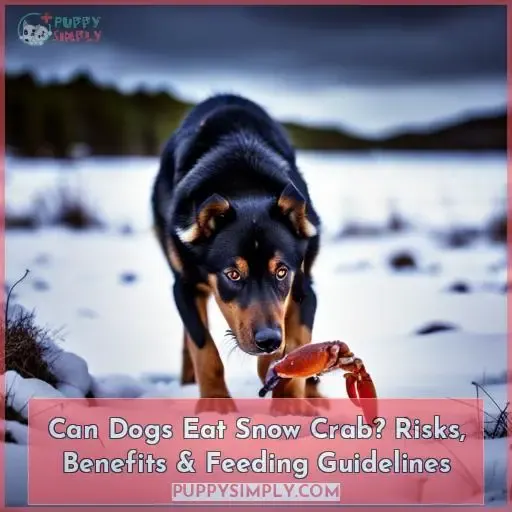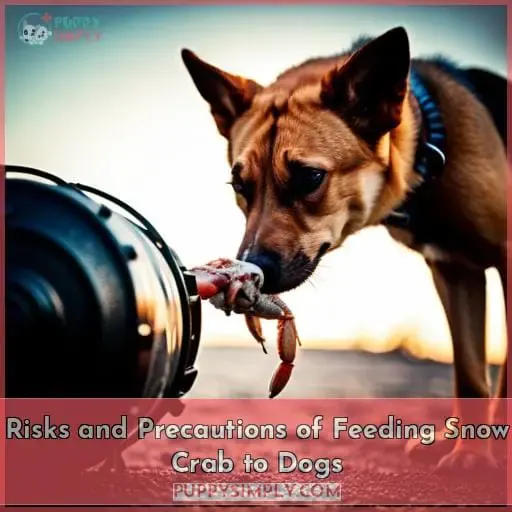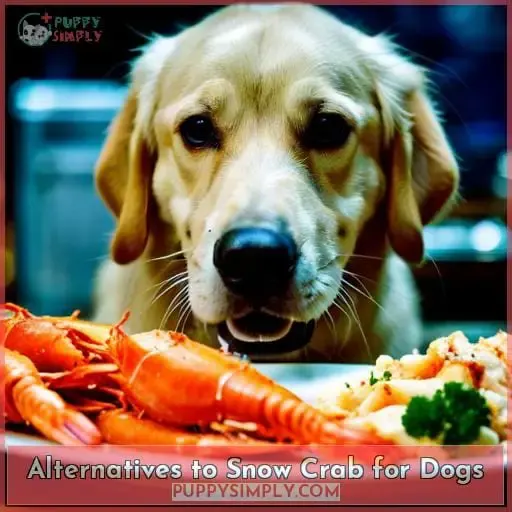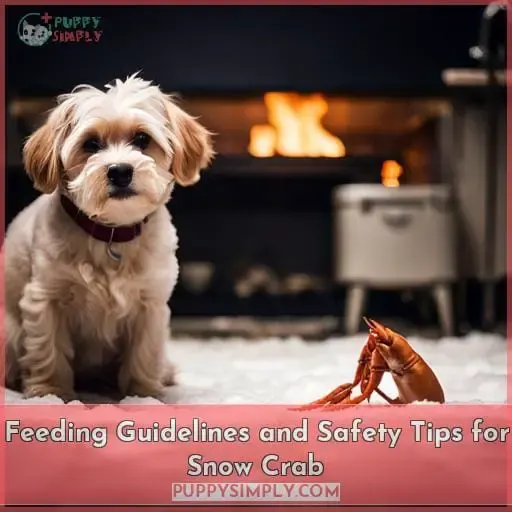This site is supported by our readers. We may earn a commission, at no cost to you, if you purchase through links.
 Is your pup begging for a taste of the sea? While some dogs can safely enjoy crab meat, it’s important to take certain precautions when feeding your four-legged friend snow crab. This guide will explore whether or not dogs can eat snow crab and provide you with all the information you need to know about risks, benefits, alternatives, and more so that you can feed them safely.
Is your pup begging for a taste of the sea? While some dogs can safely enjoy crab meat, it’s important to take certain precautions when feeding your four-legged friend snow crab. This guide will explore whether or not dogs can eat snow crab and provide you with all the information you need to know about risks, benefits, alternatives, and more so that you can feed them safely.
From understanding raw snow crabs’ parasite risks to learning how digestible shell fragments are for pups—this article has got everything covered! So before allowing Fido near those tasty morsels from under the sea, let’s dive into what every pet parent should know first.
Table Of Contents
Key Takeaways
- Dogs can eat snow crab when properly cooked and shell-free.
- Cooking eliminates bacterial contaminants and parasites.
- Snow crab offers amino acids, B12, and zinc.
- Portion size is based on the dog’s size (up to 1/4 cup per 20 lbs).
Can Dogs Eat Snow Crab?
You may be wondering if your furry friend can enjoy the sweet, succulent taste of snow crab, but it’s important to understand the risks and benefits before introducing this seafood treat.
Snow crab is generally safe for dogs in small portions when cooked correctly and without its shell. However, allergies or choking risk are possible due to its hard texture which could also lead to gastrointestinal issues if not properly chewed by your pup.
It’s a good idea to remove all shells from any type of seafood before feeding it as an added precaution against choking hazards or gastric irritation that may occur with digestion.
Additionally, you should consider portion size depending on how large your dog is; too much snow crab might cause digestive problems like vomiting or diarrhea so start off slow with smaller servings until determining what works best for them!
Lastly, make sure you cook the meat thoroughly since some bacterial contaminants found in raw fish can put pets at risk even though they’re able to eat raw food more easily than humans do.
Risks and Precautions of Feeding Snow Crab to Dogs
It’s important to understand the risks associated with feeding snow crab to dogs. Raw snow crab can pose a risk of parasites, while cooked or uncooked shells may result in injuries for your pup. Knowing these potential dangers is key when considering whether you should give your dog this type of seafood.
Raw Snow Crab and Parasite Risks
It’s crucial to be mindful of the risks associated with raw snow crab, as parasites can quickly become a problem for your pup. Cooking methods are necessary when feeding dogs snow crab due to its chitin shell, which harbors harmful bacteria and parasites.
Allergic reactions need to be considered too; these can lead to dangerous electrolyte imbalances caused by high iodine levels in crabs or excessive sodium intake from their shells.
Nutritional value is also important. Although snow crab contains essential amino acids, vitamin B12, and zinc, it’s essential to monitor closely if introducing new foods like this one.
For parasite prevention and balanced nutrition, consider choosing other lean protein sources without artificial ingredients for your dog, such as chicken or turkey, instead of potentially dangerous snowy crabs!
Potential Injuries From Snow Crab Shells
Be aware that snow crab shells can cause potential injuries to your pup if ingested. Shell fragments and splinters can puncture paws, throats, or intestines. If you’re looking to add some crab meat into your dog’s diet for the health benefits it offers, make sure to pick out pieces without the shell on them.
The dietary needs of each individual dog should be taken into account when making decisions about a safe and healthy diet; seek advice from a vet before introducing any new food item like snow crab into their routine.
And don’t forget: moderation is key when feeding seafood-based items like snow crab as part of a regular diet – too much may lead to an imbalance in sodium levels within their body systems which could result in serious consequences for overall canine health down the line!
Benefits of Snow Crab Meat for Dogs
Snow crab can provide your pup with essential nutrition. It’s a lean protein source, supplying essential amino acids and vitamins like B12 and zinc to support digestive health. Omega-3 fatty acids in snow crab are beneficial for heart, skin, kidney function, as well as joint pain relief.
Plus, the low amount of cholesterol makes it an ideal dietary option for dogs who need to watch their weight or have high blood pressure. Allergic reactions should be monitored, though. If signs of intolerance arise, then discontinue feeding immediately and contact your vet right away.
Overall, adding some snow crab into a balanced diet is a great way to give your dog extra nutrients without compromising on taste or quality!
Can Dogs Eat Snow Crab Shells?
Considering snow crab shells for your pup? It’s important to understand the safety considerations and digestibility of this food before offering it as a treat. Snow crab shells are considered safe for dogs in moderation, but may present potential risks depending on how they’re prepared.
Dogs can typically consume cooked snow crabs without adverse effects; however, raw or unprocessed versions may cause digestive distress or even injury due to sharp edges.
Safety Considerations for Eating Snow Crab Shells
When it comes to snow crab shells, you should be aware of the potential risks and proceed with caution. One study found that over 75% of dogs experienced allergic reactions when consuming shellfish. Snow Crab Shells can contain sharp fragments which may cause injury or discomfort if ingested by your dog.
Additionally, there is no guarantee that a dog will be able to digest the shells either partially or completely. Undigested pieces could lead to intestinal problems. To avoid these issues altogether, it’s best not to let your pup consume any part of a snow crab shell at all.
Other dangers include ingesting raw crabs as well as allergies. So make sure you only offer small portions cooked thoroughly before introducing them into Fido’s diet plan.
Taking precautionary measures like this will ensure Happy Tummy Time in both humans and furry friends alike!
Digestibility of Snow Crab Shells for Dogs
It’s important to understand how your pup may digest snow crab shells before giving them a try. Snow crab shells are high in calcium, which can be beneficial for bones and teeth, but they’re also hard to break down.
Cooking the shell is an option; however, it might not make digestion any easier for dogs due to their sensitive digestive system. Allergic reactions may occur as well since many crabs contain iodine or sodium that could have negative effects on your dog’s diet.
It’s best to consult with a veterinarian if you plan on introducing this food into your pet’s diet.
Keep the nutritional value of snow crabs balanced with other sources like lean proteins such as chicken, turkey, or beef.
Alternatives to Snow Crab for Dogs
If you’re looking for an alternative to snow crab for your pup, consider lean proteins like chicken, turkey, and beef. These dog-friendly proteins are highly nutritious substitutes that provide safe seafood options without the risks of parasites or injury from shells.
Protein-rich alternatives such as fish fillets can also be served in moderation with careful preparation and monitoring. Other canine dietary options include egg whites, yogurt, and cottage cheese, which offer a healthy balance of vitamins, minerals, and essential fatty acids.
Avoid processed fish products due to high sodium content, which can lead to dangerous electrolyte imbalances in dogs if consumed regularly. Choose quality ingredients whenever possible over artificial ones that lack natural nutrition value for your pet’s long-term health benefits.
Feeding Guidelines and Safety Tips for Snow Crab
To keep your pup safe, adhere to feeding guidelines and safety tips for snow crab – no more than 1/4 cup per 20 lbs of body weight at a time is recommended.
To minimize the risk of shell splinters or parasites:
- Cook thoroughly before offering it to your dog
- Remove all shells when possible
- Consult a veterinarian if you have any questions about introducing snow crab into your dog’s meal plan
When done right, feeding dogs snow crab can be beneficial due to its high nutritional value. Snow crabs are rich in lean proteins and essential fatty acids like omega-3s that promote healthy skin, heart function, and kidney health for dogs.
Just remember moderation is key; too much salt from seafood can lead to electrolyte imbalances in canine bodies just as it does humans’. If you’re looking for an alternative beach snack while enjoying some sun on the sand this summer, opt out of sharing those salty snacks with Fido! Instead, seek advice from veterinarians who specialize in nutrition regarding which foods are suitable alternatives during outdoor excursions together.
Conclusion
Snow crab is a delicious and nutritious treat that can be enjoyed by your pup, but it’s important to remember that there are risks associated with feeding it. Raw snow crab can contain parasites, and its shells can pose a choking or injury hazard.
To ensure your pup’s safety, it’s important to monitor them for allergic reactions and digestive issues when introducing new foods.
For a safer alternative, consider lean proteins like chicken, turkey, or lean beef. When feeding snow crab to your pup, opt for small plain pieces and consult a vet beforehand. With the right precautions, your pup can safely enjoy the deliciousness of snow crab.











